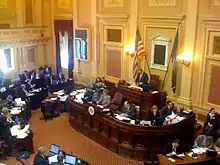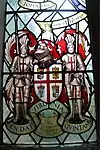Virginia Senate
Senate of Virginia | |
|---|---|
| 162nd Virginia General Assembly | |
 | |
| Type | |
| Type | |
Term limits | None |
| History | |
New session started | January 8, 2020 |
| Leadership | |
Majority Leader | |
Minority Leader | |
| Structure | |
| Seats | 40 |
 | |
Political groups | Majority
Minority
Other
|
Length of term | 4 years |
| Authority | Article IV, Virginia Constitution |
| Salary | $18,000/year + per diem |
| Elections | |
Last election | November 5, 2019 (40 seats) |
Next election | November 7, 2023 (40 seats) |
| Redistricting | Commission |
| Meeting place | |
 | |
| State Senate Chamber Virginia State Capitol Richmond, Virginia | |
| Website | |
| Virginia General Assembly | |
The Senate of Virginia is the upper house of the Virginia General Assembly. The Senate is composed of 40 senators representing an equal number of single-member constituent districts. The Senate is presided over by the lieutenant governor of Virginia. Prior to the American War of Independence, the upper house of the General Assembly was represented by the Virginia Governor's Council, consisting of up to 12 executive counselors appointed by the colonial royal governor as advisers and jurists.
The lieutenant governor presides daily over the Virginia Senate. In the lieutenant governor's absence, the president pro tempore presides, usually a powerful member of the majority party. The Senate is equal with the House of Delegates, the lower chamber of the legislature, except that taxation bills must originate in the House, similar to the federal U.S. Congress. The 40 senatorial districts in Virginia elect their representatives every four years on the Tuesday following the first Monday in November. The last election took place in November 2019. There are no term limits for senators. The Senate also employs 36 pages (ages 13–14) to help with daily tasks during each general session in a full-time residential program of high regard.

History
The Senate of Virginia was created by the 1776 Constitution of Virginia, and originally consisted of twenty-four members.[1] Along with the House of Delegates, the Senate comprised a new bicameral legislature designed to replace the colonial Virginia House of Burgesses, which formally dissolved on May 6, 1776.[2] The Senate replaced the legislative functions of the appointed Virginia Council of State.
Pursuant to the original Virginia Constitution, the Senate was only permitted to file amendments, while the House of Delegates had the power to propose bills. Accordingly, the Senate had far less power than the House, until the revised Virginia constitution of 1851 allowed the Senate to propose new laws.[3]
In the 2007 elections, the Democratic Party reclaimed the majority in the Senate for the first time since 1995, when the Republican Party gained a 20–20 split. The Republicans took control of the Senate for the first time in history after a January 1998 special election. The 2011 elections resulted in a 20–20 split between the parties, but as the tie breaker was Republican lieutenant governor Bill Bolling, the Republicans effectively regained control.[4]
After the 2013 elections, Democratic state senator Ralph Northam became the lieutenant governor, but the Democrats did not regain control of the chamber until January 28, 2014, following a series of special elections including that of Northam's vacated 6th district seat. The Democratic majority would prove short-lived, however, as Senator Phil Puckett (D-38th) resigned, effective June 8, handing the GOP a majority of 20 to 19. The Republicans solidified their majority following a special election win on August 19, 2014, which increased their total number of seats to 21.[5]
The Democratic Party regained control of Senate after the 2019 election and new members were sworn into office on January 8, 2020.[6][7] As the legislative session opened, Louise Lucas was elected as the first female and African-American President Pro Tempore.[8][9]
Salary and qualifications
The annual salary for senators is $18,000 per year.[10] To qualify for office, senators must be at least 21 years of age at the time of the election, residents of the district they represent, and qualified to vote for General Assembly legislators. The regular session of the General Assembly is 60 days long during even numbered years and 30 days long during odd numbered years, unless extended by a two-thirds vote of both houses.[11]
Composition
Historical composition
| Affiliation | Party (Shading indicates majority caucus) |
Total | ||
|---|---|---|---|---|
| Democratic | Republican | Vacant | ||
| 1900–1904 | 38 | 2 | 40 | 0 |
| 1904–1916 | 35 | 5 | 40 | 0 |
| 1916–1920 | 36 | 4 | 40 | 0 |
| 1920–1924 | 34 | 6 | 40 | 0 |
| 1924–1928 | 39 | 1 | 40 | 0 |
| 1928–1944 | 38 | 2 | 40 | 0 |
| 1944–1948 | 37 | 3 | 40 | 0 |
| 1948–1952 | 38 | 2 | 40 | 0 |
| 1952–1960 | 37 | 3 | 40 | 0 |
| 1960–1964 | 38 | 2 | 40 | 0 |
| 1964–1968 | 37 | 3 | 40 | 0 |
| 1968–1970 | 34 | 6 | 40 | 0 |
| 1970–1974 | 33 | 7 | 40 | 0 |
| 1974–1976 | 34 | 6 | 40 | 0 |
| 1976–1978 | 35 | 5 | 40 | 0 |
| 1978–1980 | 34 | 6 | 40 | 0 |
| 1980–1984 | 31 | 9 | 40 | 0 |
| 1984–1988 | 32 | 8 | 40 | 0 |
| 1988–1992 | 30 | 10 | 40 | 0 |
| 1992–1996 | 22 | 18 | 40 | 0 |
| 1996–2000 | 20 | 20 | 40 | 0 |
| 2000–2004 | 19 | 21 | 40 | 0 |
| 2004–2008 | 17 | 23 | 40 | 0 |
| 2008–2012 | 22 | 18 | 40 | 0 |
| 2012–2016 | 20 | 20 | 40 | 0 |
| 2016–2020 | 19 | 21 | 40 | 0 |
| 2020–2024 | 22 | 18 | 40 | 0 |
Current session
| Affiliation | Party (Shading indicates majority caucus) |
Total | |||
|---|---|---|---|---|---|
| Democratic | AC[12][lower-alpha 1] | Republican | Vacant | ||
| 2016-2020 legislative session | 19 | 21 | 40 | 0 | |
| End | 20 | 39 | 1 | ||
| Begin 2020 | 21 | 1 | 18 | 40 | 0 |
| January 1, 2021[lower-alpha 2] | 17 | 39 | 1 | ||
| April 2, 2021[lower-alpha 3] | 18 | 40 | 0 | ||
| November 15, 2022[lower-alpha 4] | 17 | 39 | 1 | ||
| January 18, 2023[lower-alpha 5] | 22 | 40 | 0 | ||
| March 7, 2023[lower-alpha 6] | 21 | 39 | 1 | ||
| April 11, 2023[lower-alpha 7] | 22 | 40 | 0 | ||
| September 2023[lower-alpha 8] | 16 | 39 | 1 | ||
| Latest voting share | 56.4% | 2.6% | 41% | ||
Leadership
| Lieutenant Governor | Winsome Sears |
| President pro Tempore | Louise Lucas |
| Majority Leader | Dick Saslaw |
| Minority Leader | Tommy Norment |
Committee chairs and ranking members
The Senate of Virginia has 10 Standing Committees and a Committee on Rules.[20]
| Committee | Chair | Ranking Minority Member |
|---|---|---|
| Agriculture, Conservation and Natural Resources | Chap Petersen | Emmett Hanger |
| Commerce and Labor | Dick Saslaw | Tommy Norment |
| Judiciary | John S. Edwards | Tommy Norment |
| Education and Health | Louise Lucas | Stephen Newman |
| Finance and Appropriations | Janet Howell | Tommy Norment |
| General Laws and Technology | George Barker | Frank Ruff |
| Local Government | Lynwood Lewis | Emmett Hanger |
| Privileges and Elections | Creigh Deeds | Jill Vogel |
| Rehabilitation and Social Services | Barbara Favola | Emmett Hanger |
| Rules | Mamie Locke | Tommy Norment |
| Transportation | Dave Marsden | Stephen Newman |
Members
District map
.svg.png.webp)
Senate seal
The Senate of Virginia has its own coat of arms designed and granted by the College of Arms in England.[21][22] The coat of arms also makes up the official seal of the Virginia Senate. It bears no resemblance to the Seal of the Commonwealth of Virginia, which is the seal of the state as a whole.

The coat of arms adopted January 22, 1981, was designed by the College of Arms and based on the coat of arms used by the London Company, the royally-chartered English entrepreneurs who funded the European settlement of Virginia. This is not to be confused with the Seal of the London Company, for other than both devices displaying a quartered shield, there is little resemblance between them.
The Senate's arms have a shield in the center which is divided into four sections by a red cross. In each quarter are smaller shields representing the arms of four countries (England, France, Scotland, and Ireland) that contributed settlers to Virginia's early waves of European immigration.[21][22]
The four coats of arms, a small crest of a crowned female head with unbound hair representing Queen Elizabeth (the Virgin Queen who named Virginia),[23] and the dragon (part of the Elizabethan royal seal of England) represent Virginia's European heritage.[21][22]
An ivory gavel emblazoned on the vertical arm of the red cross represents the Senate as a law making body. The cardinal and dogwood depicted are Virginia's official state bird and tree. The ribbon contains the Latin motto of the Senate, Floreat Senatus Virginiae, which means "May the Senate of Virginia flourish."[21][22]
Past composition of the Senate
See also
Notes
- Amanda Chase is an enrolled Republican, and was elected in 2019 on the Republican line. On November 22, 2019, she announced that she would not caucus with the Republicans in the upcoming Senate session, although she still considers herself a Republican. (Chase also ran for the Republican nomination in the 2021 Virginia gubernatorial election.)
- Republican Ben Chafin (District 38) died.[13]
- Republican Travis Hackworth was sworn in following a March 23 election to succeed Chafin.[14]
- Republican Jen Kiggans (District 7) resigned after being elected to the U.S. House.[15]
- Democrat Aaron Rouse was sworn in following a January 10 election to succeed Kiggans.[16]
- Democrat Jennifer McClellan (District 9) resigned after being elected to the U.S. House.[17]
- Democrat Lamont Bagby was sworn in following a March 28 election to succeed McClellan.[18]
- Republican John Cosgrove (District 14) resigned after being appointed to the Virginia Marine Resources Commission.[19]
References
- "Constitution of Virginia, 1776" (PDF). Retrieved January 30, 2014.
- "The General Assembly Adjourns (1776)". Encyclopedia of Virginia. Virginia Foundation for the Humanities. Retrieved January 31, 2014.
- "House of Burgesses". Encyclopedia of Virginia. Virginia Foundation for the Humanities. Retrieved January 31, 2014.
- Walker, Julian (November 9, 2011). "Virginia Republicans claim victory in state Senate". The Virginian-Pilot. Retrieved 2013-01-25.
- Vozella, Laura (2014-06-09). "GOP controls Va. Senate, will force budget deal". The Washington Post.
- "Newly-Empowered Virginia Democrats Promise Action".
- "Article - Chron".
- "Opinion | Social issues will loom large in Virginia Senate - The Washington Post". The Washington Post.
- "History-making new Va. House speaker cites passing of 'new torch' with focus on diversity, empowerment".
- "Virginia State Legislature" (PDF). VAKids.org. Retrieved 2008-09-12.
- "Constitution of Virginia; Article IV; Section 6". Virginia Legislative Information Services. Retrieved 2 March 2016.
- "Sen. Amanda Chase leaves caucus after Norment elected as Senate minority leader". WTVR.com. 2019-11-22. Retrieved 2020-01-06.
- "A Virginia state senator, Ben Chafin, has died from complications of Covid-19". The New York Times. 2021-01-01. Retrieved 2023-04-17.
- "Travis Hackworth sworn into office for Virginia's 38th Senate District seat". WCYS.com. 2021-04-03. Retrieved 2023-04-17.
- "Special election to fill Kiggans' Virginia Senate seat set for Jan. 10". WRIC.com. 2022-11-15. Retrieved 2023-04-17.
- "Aaron Rouse sworn into Virginia Senate". WRIC.com. 2023-01-18. Retrieved 2023-04-17.
- "Special election to fill McClellan's Virginia Senate seat set for March". WRIC.com. 2023-02-22. Retrieved 2023-04-17.
- "7 developments from Wednesday's Virginia General Assembly session". Richmond Times-Dispatch. 2023-04-13. Retrieved 2023-04-17.
- "Youngkin appoints Byron, Roth to workforce posts". Richmond Times-Dispatch. 2023-09-30. Retrieved 2023-10-20.
- "Legislative Committees". Legislative Information System. Virginia General Assembly. Retrieved 2016-01-14.
- Official Virginia State Senate "Capitol Classroom" site Archived 2012-09-26 at the Wayback Machine. Accessed November 7, 2007.
- Answers.Com: Virginia State Senate Seal; accessed November 7, 2007.
- The Queen named Virginia in 1584 by modifying a Native American regional "king" named "Wingina". Stewart, George (1945). Names on the Land: A Historical Account of Place-Naming in the United States. New York: Random House. p. 22.
External links
- Virginia General Assembly official government website
- Project Vote Smart – State Senate of Virginia at the Library of Congress Web Archives (archived 2008-09-18)
- Official Virginia Emblems at the Wayback Machine (archived 2008-05-11) Includes a very small version of the Seal of the Senate of the Commonwealth of Virginia